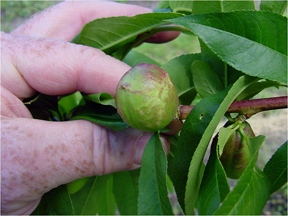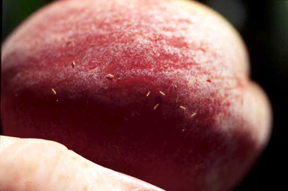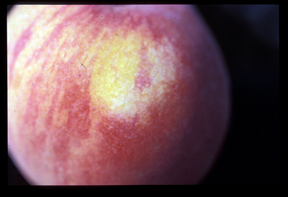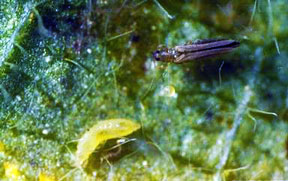Managing western flower thrips in peaches and nectarines
Editor’s note: This article is from the archives of the MSU Crop Advisory Team Alerts. Check the label of any pesticide referenced to ensure your use is included.
Western flower thrips (Frankliniella occidentalis) are a common pest of several crops, including peaches, nectarines, plums and apple. In Michigan, western flower thrips are most visible as a pest in peach, where late season feeding by thrips results in “silvering” and defuzzing of peaches in the weeks leading up to harvest. The damage is more conspicuous on the blush side of the fruit, and can result in downgrading fruit to U.S. #2 grade. Silvering damage is more conspicuous on highly colored fruit. In some seasons, thrips can be found inside the shucks of developing nectarines and plums where they can cause crescent-shaped scars (nectarines) or blotches (plum) that remain conspicuous at harvest.
The insect overwinters as adults in weeds. Adults are approximately 1 mm in length, have two pairs of wings that are folded along the back covering a striped abdomen. In spring, the adults fly to flowering plants and eventually onto developing fruit. Western flower thrips fly in short loops when disturbed, much like leafhoppers. Several generations are produced per year. Immature western flower thrips are less than one millimeter in length, slender and range from yellow to brown and move slowly on plant surfaces. Hot, dry conditions tend to favor thrips development.
Extension guidelines in California and Pennsylvania, where western flower thrips are a regularly occurring problem, recommend sampling blooms from 10 to 12 trees at each of three to four sites per orchard, and looking at the blooms against a light yellow surface to determine abundance of adults. The presence of larvae is determined by dissecting at least 50 blooms per orchard. The extension guidelines recommend treatment if adults infest more than five per 50 blooms or if larvae are present. The second critical monitoring period is when the first fruit ripens. Count the number of adult thrips on 10 fruits at each of five sites per orchard. Sample fruit from the ends of branches in the lower third of the canopy. Five adult thrips per 50 fruits and the presence of silvering may indicate a damaging population.
Control of western flower thrips can be aided by preventing growth of weedy areas in and adjacent to orchards. Controlling weed growth suppresses thrips buildup, reducing migration into orchards. Pennslyvania Extension guidelines recommend proper thinning to reduce the amount of protected feeding sites between fruit, reducing the amount of clover in row middles, not mowing adjacent fields or weedy row middles during bloom or harvest, and avoiding the use of insecticides, such as Sevin, that are not effective against western flower thrips and may actually increase the amount of injury occurring during harvest by killing natural enemies.
Little work has been done in recent years in Michigan to evaluate control of western flower thrips with insecticides. Table 1 summarizes efficacy trials conducted by colleagues from Washington, California and Pennsylvania for western flower thrips control with labeled pesticides. Carzol is an effective material. It is not labeled for use after petal fall on peaches and nectarines but still has good residual action against thrips that would otherwise build up in the shuck. Delegate provides the best spray option close to harvest with its activity against western flower thrips and oriental fruit moth.
Table 1. Preharvest interval and relative efficacy of insecticides against western flower thrips and oriental fruit moth on peaches and nectarines.
| Material | Preharvest interval (days) | Rating | Oriental fruit moth |
| Carzol | Not after petal fall | Excellent | Not after petal fall |
| Lannate SP | 1 nectarine, 4 peach | Fair | Fair |
| Provado | 0 | Poor | None |
| SpinTor 2 SC | 1 nectarine, 14 peach | Excellent | Fair |
| Actara 25 WG | 14 | Fair | None |
| Delegate WG | 1* | Excellent | Excellent |
| Movento | 7 | Probably good | Not rated |
| Voliam Flexi WG | 14 | Fair | Excellent |



 Print
Print Email
Email






